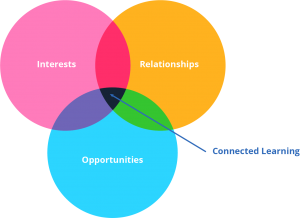Learning happens in both formal settings like school, and informal spaces such as museums, libraries, afterschool clubs, and online affinity spaces. At museums and libraries, youth can engage in following passions on a wide range of interest-driven topics, from makerspaces to retro-videogaming. In afterschool clubs, youth may learn 3D printing, computer coding, digital photography, or debate skills. In online affinity spaces, youth can explore other interests not always available locally. Online they can connect with others who share similar interests in video gaming, sports, or music. Of note are fans of Korean pop music, or K-pop. (For more on K-pop fandom, check out this article about being a BTS fan.)

HPA’s Dumbledore’s Army
Some online fan sites include opportunities for youth to connect “IRL” (IRL is internet shorthand for “in real life”). The Harry Potter Alliance (HPA) is an example, where fans of the boy wizard mentor others in becoming “fan activists.” Local HPA chapters are where members can enroll in Wizard Activist School. Using the hashtag, #DAFightsBack, HPA members join Dumbledore’s Army where they fight for social change through letter-writing campaigns and petition writing. HPA fan activists also gather at political marches about LGBTQIA+ Equality, gender equality, and racial justice.
As an educator in this space, I wondered how youth learn about fan activist sites like HPA. As it turns out, there is a wealth of resources, including research from the Connected Learning Lab, at the University of California, Irvine. There, researchers use the Elements of Connected Learning framework, which situates connected learning at the nexus of youth interests, opportunities, and relationships (see image below).

Elements of Connected Learning
The Elements of Connected Learning stem from the Principles of Connected Learning Framework, which focuses on three learning principles—academically oriented, interest-powered, and peer-supported; and three design principles—production-centered, openly networked, and shared purpose. The Principles of Connected Learning stem from interest-driven and peer-supported practices that can occur in school, but more typically are found informally outside of school such as in online communities of practice. Thus, if a teen has an interest in Harry Potter, he or she may discover fan fiction websites, which may lead to fan activism networks like the HPA. To learn more, read the report.
Reclaiming Digital Futures
Reclaiming Digital Futures is a new, free toolkit based on research in out-of-school learning. The toolkit aims to help community-based organizations harness digital learning in five areas: pedagogy, skills, technology, community, and capacity. What’s more, it addresses how youth interests lead to opportunities and real-world relationships.
The researchers found several themes across community-based organizations, including the youth voice and power, connections to work, and ways of rethinking how we might imagine youth pathways into opportunity. I spoke with researcher Rafi Santo, to find out more.
“A lot of this came out in modes of apprenticeship-based learning,” Santo began. “We had a series of resources on client-based work, which included in-house social entrepreneurship projects, where more advanced and highly skilled youth do work for hire for clients.”
Like fan activism, client-based work are spaces where interests meet opportunities and relationships. One example of in the toolkit took place at Free Spirit Media, a documentary film studio based in Chicago. There, Free Spirit Media has a project called Free Spirit PRO where non-profit municipal organizations and for-profit companies can hire young people to produce public service announcements (PSAs), as well as event videos that serve a specific client need. Similar youth-driven client-based work includes the Digital Harbor Foundation’s (DHF)’s 3D Print Shop, where youth can create 3D models and prototypes for clients, and the Ambrose Print Shop, a screen-printing social venture for T-shirts and poster making.
To learn more about the Reclaiming Digital Futures toolkit, read my related blog post on Edutopia, Using Digital Tools to Promote Social and Emotional Learning.
Educators as Learning Brokers
Educators can view their role through lenses, like being a knowledge-builder, or as a curator of learning opportunities. Educators can also take on the role of learning broker. “It is actually distinct from [being a knowledge-builder],” Santo explained.
Brokers facilitate connections. “You first open up worlds through ideas, a way that is emotionally resonant and creates encouragement and a positive feedback around youth engagement in ideas,” Santo continued. “There also needs to be a piece about the next step to bring it into the real world. Let’s say youth have interest in issues about mental health. The next step might be to help youth find an internship in mental health. All educators can play that role.”
I spoke with Lori Takeuchi, to learn more about being a learning broker. Takeuchi is the Deputy Director and Head of Research at the Joan Ganz Cooney Center at Sesame Workshop. She has collaborated with Santos, and is also the co-author of Learning Across Boundaries: How Parents and Teachers are Bridging Learning Across Settings, a report that surveyed parents and pre-K-8 teachers to learn about learning experiences at home, at school, and in the community.
“Brigid Baron came up with brokering in this context,” Takeuchi began. Baron, along with Caitlin Kennedy Martin, Takeuchi, and Rachel Fithian authored the influential article, Parents as Learning Partners in the Development of Technological Fluency. In it, a taxonomy of parents’ roles in supporting children’s learning was produced, which shows how parents and teachers play different roles in brokering youth interests to opportunities. “We found that parents play an intermediary role of connecting the child to other people in the community,” Takeuchi said. “Brokering also occurs in different age ranges and contexts.”
To learn more about brokering youth to future opportunities, check out the free toolkit, Brokering Youth Pathways. This toolkit also offers a framework that can guide out-of-school organizations to program based on youth interests.
For breakfast, I had Special K Protein cereal, turkey bacon, and Starbucks coffee.
Author: @drfarber
